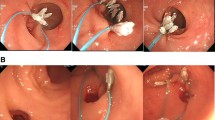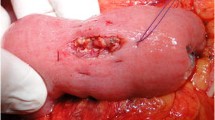Abstract
Background
Serious complications due to perforation restrict the development of duodenal endoscopic treatment. The key stage for remediation is the successful endoscopic closure to prevent peritonitis and the need for surgical intervention. This report aimed to present a new simple method for the closure of large iatrogenic duodenal perforations with purse-string sutures using the novel endoloops and repositionable clips through a single-channel endoscope.
Methods
A total of 23 patients with iatrogenic duodenal perforations ≥ 1 cm were retrospectively studied who were presently treated by purse-string sutures using the novel endoloops and the repositionable hemostasis clips with the single-channel endoscope at four institutes. During and after the procedure, a 20-gauge needle was used to relieve the pneumoperitoneum or subcutaneous emphysema. Finally, a gastroduodenal decompression tube was placed.
Results
The median maximum diameter of iatrogenic duodenal perforations was 1.65 cm (range 1.0–3.0 cm). Complete endoscopic closure of all 23 perforations was achieved. No patient had severe complications such as peritonitis. The wounds were healed and no obvious duodenal stricture was observed in all cases after 3 months.
Conclusion
Purse-string sutures using the novel endoloops and repositionable endoclips through single-channel endoscope were feasible, effective and easy methods for the closure of large duodenal iatrogenic perforations.



Similar content being viewed by others
References
Fujihara S, Mori H, Kobara H et al (2016) Management of a large mucosal defect after duodenal endoscopic resection. World J Gastroenterol 22(29):6595–6609
Shi Q, Chen T, Zhong YS et al (2013) Complete closure of large gastric defects after endoscopic full-thickness resection, using endoloop and metallic clip interrupted suture. Endoscopy 45(5):329–334
Zhang Y, Wang X, Xiong G et al (2014) Complete defect closure of gastric submucosal tumors with purse-string sutures. Surg Endosc 28(6):1844–1851
Ye LP, Yu Z, Mao XL et al (2014) Endoscopic full-thickness resection with defect closure using clips and an endoloop for gastric subepithelial tumors arising from the muscularis propria. Surg Endosc 28(6):1978–1983
Paspatis GA, Dumonceau JM, Barthet M et al (2014) Diagnosis and management of iatrogenic endoscopic perforations: European Society of Gastrointestinal Endoscopy (ESGE) position statement. Endoscopy 46(8):693–711
Donatelli G, Vergeau BM, Dritsas S et al (2013) Closure with an over-thescope clip allows therapeutic ERCP to be safely performed after acute duodenal perforation during diagnostic endoscopic ultrasound. Endoscopy 45(Suppl 2):E392–E393
Merchea A, Cullinane DC, Sawyer MD et al (2010) Esophagogastroduodenoscopy-associated gastrointestinal perforations: a single-center experience. Surgery 148(4):876–880
Honda T, Yamamoto H, Osawa H et al (2009) Endoscopic submucosal dissection for superficial duodenal neoplasms. Dig Endosc 21(4):270–274
Prachayakul V, Aswakul P (2014) Endoscopic retrograde cholangiopancreatography-related perforation: management and prevention. World J Clin Cases 2(10):522–527
Hanaoka N, Uedo N, Ishihara R et al (2010) Clinical features and outcomes of delayed perforation after endoscopic submucosal dissection for early gastric cancer. Endoscopy 42(12):1112–1115
Raju GS (2014) Endoscopic clip closure of gastrointestinal perforations, fistulae, and leaks. Dig Endosc 26(Suppl 1):95–104
Ghossaini AI, Lucidarme N, Bulois D P (2014) Endoscopic treatment of iatrogenic gastrointestinal perforations: an overview. Dig Liver Dis 46(3):195–203
Kantsevoy SV, Bitner M, Mitrakov AA et al (2014) Endoscopic suturing closure of large mucosal defects after endoscopic submucosal dissection is technically feasible, fast, and eliminates the need for hospitalization (with videos). Gastrointest Endosc 79(3):503–507
Schmidt A, Damm M, Caca K (2014) Endoscopic full-thickness resection using a novel over-the-scope device. Gastroenterology 147(4):740–742
Mori H, Shintaro F, Kobara H et al (2013) Successful closing of duodenal ulcer after endoscopic submucosal dissection with over-the-scope clip to prevent delayed perforation. Dig Endosc 25(4):459–461
Nakagawa Y, Nagai T, Soma W et al (2010) Endoscopic closure of a large ERCP related duodenal perforation by using endoloops and endoclips. Gastrointest Endosc 72(1):216–217
Zeng CY, Li GH, Zhu Y et al (2015) Single-channel endoscopic closure of large endoscopy-related perforations. Endoscopy 47(8):735–738
Huang S, Zhu S (2017) Closure of duodenal ulcer perforation using a novel endoloop device with a single-channel gastroscope after failed laparoscopic repair. Endoscopy 49(S 01):E31–E32
Acknowledgements
This work is supported in part by the grants from Jiangsu Youth Medical Key Talents Cultivation (QNRC2016442) and Jiangsu dual creation project (2017-37).
Author information
Authors and Affiliations
Corresponding authors
Ethics declarations
Disclosures
Sumin Zhu, Jie Lin, Fazhen Xu, Simin Guo, Shu Huang, and Min Wang have no conflict of interest or financial ties to disclose.
Electronic supplementary material
Below is the link to the electronic supplementary material.
Supplementary material 1—Video 1: Purse-string suture using the novel endoloop and repositionable clips to repair a duodenal defect from EFTR with single-channel endoscope (MP4 25327 KB)
Rights and permissions
About this article
Cite this article
Zhu, S., Lin, J., Xu, F. et al. Purse-string sutures using novel endoloops and repositionable clips for the closure of large iatrogenic duodenal perforations with single-channel endoscope: a multicenter study. Surg Endosc 33, 1319–1325 (2019). https://doi.org/10.1007/s00464-018-6586-1
Received:
Accepted:
Published:
Issue Date:
DOI: https://doi.org/10.1007/s00464-018-6586-1




